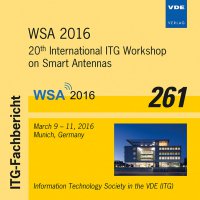Coded CSI Reference Signals for 5G - Exploiting Sparsity of FDD Massive MIMO Radio Channels
Konferenz: WSA 2016 - 20th International ITG Workshop on Smart Antennas
09.03.2016 - 11.03.2016 in München, Deutschland
Tagungsband: WSA 2016
Seiten: 8Sprache: EnglischTyp: PDF
Persönliche VDE-Mitglieder erhalten auf diesen Artikel 10% Rabatt
Autoren:
Zirwas, Wolfgang; Amin, Muhammad Bilal (Nokia Networks, Munich, Germany)
Sternad, Mikael (Signals and Systems, Uppsala University, Sweden)
Inhalt:
Future 5G systems are expected to provide higher performance, partly unleashed by massive MIMO as well as tight cooperation like joint transmission CoMP. For paired and unpaired spectrum below 6 GHz RF-frequency bands, frequency division duplex as well as time division duplex (FDD/TDD) has to be supported. The use of large cooperation areas over several cells together with massive MIMO downlink transmission is challenging in particular for FDD systems, due to two requirements. First, the channel state information (CSI) for downlinks from a large number of antennas has to be obtained without unreasonable overhead due to the transmission of orthogonal downlink reference (pilot) signals from these antennas. Second, relevant channel estimates have to be made available at the network side without an unrealistic uplink control signaling overhead. Pilot contamination has been extensively discussed in the literature as upper bounding performance, due to either exploding overhead for orthogonal reference signals or due to limited CSI accuracy, which is detrimental especially for sensitive interference cancellation schemes. We here propose a strategy for channel estimation of a large number of FDD downlink channels that works without an unreasonable pilot overhead. Analysis of channel statistics for urban macro scenarios applying massive MIMO - potentially combined with strong UE beamforming - reveal a sparse nature of the typical channel matrices. We propose a coded allocation of CSI reference signals, inherently exploiting this sparse nature. It allows accurate CSI estimation of UE individual subsets of relevant channel components despite a very low reference signal overhead of typically less than 5 percent.


